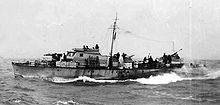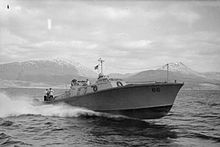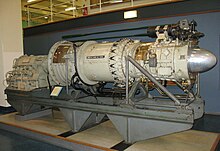Motor gunboat
This article needs additional citations for verification. (October 2007) |

The motor gun boat (MGB) was a small, high-speed British military vessel of the Second World War, which was armed with a mix of guns, in contrast to the physically similar motor torpedo boat (MTB), whose main offensive weapon were torpedoes. The small size of the MGBs, and their high speed, made them difficult targets for German E-boats, though, like their opponents, they were limited by heavy weather, because they did not provide a stable-enough platform to aim the guns.[1] The large number of guns meant the crew was relatively large, numbering as high as thirty men on the largest boats.
Description[]
MGBs were extremely heavily armed for vessels of their size. By 1945, MGB 658 carried two power-mounted QF 6-pounders in the A and Y turret positions, a twin 20 mm Oerlikon cannon in the X turret position, a single 20 mm Oerlikon on either side forward of the bridge, and two twin .303 Vickers machine guns on the bridge wings. They were also equipped with smoke-making equipment, basic radar and depth charges.
Service[]

In the early years of the war, MGBs saw action defending shipping against enemy torpedo boats, such as the German E-boats, on the southern and eastern coasts of the UK. MGBs were also involved in the protection of shipping after D-Day.
Robert Ryder used an MGB for command of the St Nazaire Raid. Ryder and William Savage, the gunner of the unprotected two-pounder gun on MGB 314, received Victoria Crosses for their part in the raid.
In the Mediterranean, MGBs were used in an attacking role to sink Italian and German shipping. They were formed into flotillas which often operated alongside motor torpedo boats (or US PT boats)[2] and helped interdict supplies being sent from Italy to Axis forces in North Africa in 1943. After that campaign, they moved northwards and assisted with the invasion of Sicily, Sardinia, Corsica and Elba.
Operating from island bases they patrolled along the western coast of Italy, attacking small coastal ships and E-boats until mid-1944. As Italy was progressively liberated, certain flotillas, such as the 56th, were sent around Italy to the Adriatic to assist partisans in the islands off Yugoslavia.
MGBs did not take the prefix HMS as they were boats, not ships, and instead used the prefix "HMMGB" on formal occasions. The crews generally referred to them by their numbers.
In 1947, MGB 2009 was fitted with a Metrovick gas turbine, thereby becoming the world's first gas turbine powered naval vessel.
Types[]

British Powerboats[]
BPB built 34 72-ft MGBs. Capable of 40 knots they carried a 2-pounder gun for engaging other vessels, with twin 20mm and two twin .303-in machine guns for defence from aircraft.
- 71½ ft Motor Gun Boat
- Over one hundred built, first ones were given identities MGB 74-97[3]
Camper and Nicholson[]
Dimensions for the motor gunboats (MGB 502 to MGB 509):
- Length: 117 ft (36 m)
- Beam: 20 ft 3 in (6.17 m)
- Draught: 4 ft 1 in (1.24 m)
- Displacement: 95 tons
- Propulsion: 3 × Paxman VRB diesel engines
- Total power output: 3,000 bhp
- Speed:
- Maximum: 28 knots (52 km/h)
- Continuous: 25 knots (46 km/h)
- Complement: 21
- Endurance: 2,000 nautical miles (4,000 km) at 11 knots (20 km/h)
MGB 509 was powered by three Packard supercharged petrol engines giving a total output of 4,050 bhp (3,020 kW) and a maximum speed of 31 knots (27 knots continuous). Later re-numbered MGB 2009, the central engine was replaced with a Metrovick F.2 gas turbine engine in 1947.
Elco[]
Elco built twelve 70 ft (21 m) MGBs for the Royal Navy.
Higgins[]
Higgins built 12 70 ft (21 m) MGBs and 15 82 ft (25 m) MGBs.
Fairmile designs[]
Fairmile Marine produced designs for small craft for the Royal Navy but most construction was carried out in other yards. The Fairmile C motor gun boats were 110 ft (34 m) long boats.
For flexibility the following Fairmile D design (approx. 200 built) could be fitted out either as MGB or MTB. These equipped the Royal Canadian Navy, Royal Navy, and Royal Norwegian Navy.
Survivors[]
The only fully restored and operational example of a Royal Navy Coastal Forces MGB which saw active service in World War II is MGB-81.[4] She was built by the British Power Boat Company, Hythe, launched in 1942, and served at the Normandy landings. She is now at Portsmouth.[5]

See also[]
- Motor launch
- Harbour defence motor launch
- Fairmile C motor gunboat
- Steam gun boat
- Motor torpedo boat
- Coastal Forces of the Royal Navy
- Type Two 63 ft HSL
- Robert Peverell Hichens, renowned MGB flotilla commander
- Guy Hamilton, film director who served on MGBs during the war.
References[]
- ^ Scott, Peter (1945). The Battle of the Narrow Seas: The History of Light Coastal Forces in the Channel and North Sea 1939-1945 (2009 Kindle ed.). Barnsley: Seaforth Publishing. ISBN 978-1-84832-035-2.
- ^ Captain Robert J. Bulkley, Jr "Part VI The Mediterranean -- Torpedo War" At Close Quarters PT Boats in the United States Navy Naval History Division, Washington: 1962
- ^ MGB-81 - 71½ FT Motor Gun Boat British Military Powerboat Team
- ^ Coastal Motorboat Heritage Trust, "MGB81" Archived 23 February 2018 at the Wayback Machine, Coastal Motorboat Heritage Trust. Retrieved 30 January 2017.
- ^ National Historic Ships UK, "MGB 81", National Historic Ships UK. Retrieved 30 January 2017.
Bibliography[]
- Motor Gunboat 658 LC Reynolds (Cassell Military Paperbacks, London, 2002) ISBN 0-304-36183-6
- Konstam, Angus (2010), British Motor Gun Boat 1939–45, New Vanguard 166, illustrated by Tony Bryan, Osprey, ISBN 9781849080774
- Kemp, Paul J (1997), British Coastal Forces of WWII, ISO Publications, London, ISBN 0-946784-52-3
External links[]
- Gunboat classes
- Boat types
- Ships of the Royal Navy